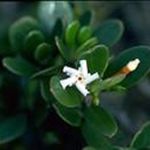| Common Name: |
Australian Quinine |
| Other Names: |
Alstonia Bark, Devil Tree, Dita bark, Fever Bark, Fever Bush, Milky Pine, Pale Mara |
| Botanical Name: |
Alstonia scholaris, Alstonia constricta |
| Genus: |
Alstonia |
| Family: |
Apocynaceae |
| Native Location: |
SE Asia |
| Cultivation: |
Moist to wet soil in sun or partial shade. |
| Propagation: |
By hardwood cuttings in moist sand in early spring, at 21°C (70°F) |
| Harvest: |
Bark is stripped and dried for liquid extracts, tinctures, decoctions, and powder. |
| Height: |
12-18m (40-60ft) |
| Width: |
6-10m (20-30ft) |
| Hardiness: |
Min. 15-18°C (59-64°F) |
| Parts Used: |
Bark |
| Properties: |
A bitter, astringent, alterative herb that lowers fever, relaxes spasms, stimulates lactation, and expels intestinal worms. It also stimulates the uterus, making it unsafe for pregnant women. |
| Medicinal Uses: |
Internally for malaria, chronic diarrhea, dysentery, and intestinal parasites.
To treat rheumatism, malaria, and diarrhea. |
| Typical Dose: |
A typical daily dose of fever bark has not been established. |
| Possible Side Effects: |
Fever bark's side effects include depression, irritability, nasal congestion, and lethargy. |
| Drug Interactions: |
| Taking fever bark with these drugs may increase or decrease the effects of the drug: |
| Albuterol, (Proventil, Ventolin) |
Brimonidine, (Alphagan P, PMS-Brimonidine Tartrate) |
Dobutamine, (Dobutrex) |
Dopamine, (Inoptrin) |
| Dopexamine, (Dopacard) |
Ephedrine, (PretzD) |
Isoetharine, (Beta2, Bronkosol) |
Isoproterenol, (Isuprel) |
| Metaproterenol, (Alupent) |
Metaraminol, (Aramine) |
Norpinephrine, (Levophed) |
Phenylephrine, (Neo-Synephrine, Vicks Sinex Nasal Spray) |
| Pseudoephedrine, (Dimetapp Decongestant, Sudafed) |
Terbutaline, (Brethine) |
| Taking fever bark with this drug may be harmful: |
| Naloxone, (Narcan)—May enhance the drugs therapeutic and/or adverse effects. |
|
| Lab Test Alterations |
- May increase 5-HIAA (5-hydroxyindolefacetic acid).
- May increase FFA (free fatty acids).
- May increase urine levels of homovanillic acid.
- May increase levels of gastric pepsin.
- May increase plasma prolactin.
- May decrease urine levels of 17-hydroxycorticosteroids.
- May decrease plasma prothrombin time.
- May decrease plasma 5-HT (5-hydroxytryptamine).
- May decrease serum T-4 (thyroxine).
- May decrease urine levels of vanillylmandelic acid.
- May decrease blood platelet levels.
- May alter results of Guaiacols spot test.
- May trigger a false positive reading on tyramine test.
|
| Economic Uses: |
Light, soft wood is used for making masks and coffins. |
| Bibliography: |
Encyclopedia of Herbs by Deni Brown Copyright © 1995, 2001 Dorling Kindersley Limited. pp 116-117
The Essential Herb-Drug-Vitamin Interaction Guide by Geo. T. Grossberg,MD and Barry Fox,PhD. Copyright©2007 Barry Fox,PhD. Pp.219-220 |

